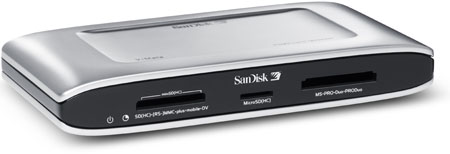Original URL: https://www.theregister.com/2007/01/24/review_sandisk_v-mate/
SanDisk V-Mate memory-card video recorder
Keep your favourite TV shows on a memory card
Posted in Personal Tech, 24th January 2007 16:54 GMT
Review Video content on mobile phones today is rich and diverse, but the cost is also rich and diverse - with an emphasis on rich. Are there any affordable alternatives to watching a variety of video on mobiles and other portable devices? SanDisk seems to think so...
SanDisk announced the V-Mate at Berlin's IFA 2006: a dinky device that can record video to various types of memory card for playback on mobile devices. Handy that, since SanDisk manufactures a wide array of memory cards. That's its angle, as simple as that.

The unit has the appearance of a plain card reader, which it can be, if you want, connecting to a PC via a USB cable. The V-Mate can handle any SD, MMC and Memory Stick PRO cards – only CompactFlash is off the guest list. This isn't a huge loss, but there's still a range of handhelds that will be left incompatible.
The V-Mate takes a composite-video input, converts picture and sound to digital, and writes the resulting video file straight to the memory card without any PC intervention. It sounds straightforward and is pretty much just that. Two cables plugged into the rear, one for the input signal - VCR, DVD, Freeview, Sky or Telewest/NTL box - the other for TV output so you can view the recording or just for set-up and scheduling.
 Here’s where we hit a minor problem. Not many video sources have a composite-video output. What’s needed here - and is sadly missing from the box - is a composite-video to SCART adaptor. Realistically this is the only way to get a signal to the unit as no Sky, Telewest or Freeview unit we could find has composite-video output.
Here’s where we hit a minor problem. Not many video sources have a composite-video output. What’s needed here - and is sadly missing from the box - is a composite-video to SCART adaptor. Realistically this is the only way to get a signal to the unit as no Sky, Telewest or Freeview unit we could find has composite-video output.
After this hurdle is overcome, setting up recording is elementary. The V-Mate boots and requires time and date to be entered via remote control. This is used to name video files, which are just the time and date. No other alternatives are possible. A minor quirk is that every time the power is lost, date and time has to be re-entered, which can be tiresome. For this review we kept the unit on standby when not in use – as it functions as a pass-through for the video signal.
A good range of pre-defined recording templates for popular mobile phones are included, such as Sony PSP, PC/TV and - recently added - Nintendo's Wii. The V-Mate uses the MPEG 4 codec for all recording - as it is properly known as that. You can select a variety of bitrates to balance picture quality and storage capacity to your tast. You can choose from a range of image resolutions, from 640 x 480 down to 176 x 144, to best suit your playback device's screen size.

Click for screen comparison of the SanDisk V-Mate card recorder
Recording is possible in two ways. First, through a live preview window, showing when to start and stop. We found a few problems here: in 640 x 480 format, the preview screen disappears. Rather disconcerting as you can no longer see when to stop. SanDisk is aware that this is an issue and is working on a solution. When the record button is pressed twice on some VCRs, 30 minutes are recorded; when pressed three times, one hour is recorded. This function is missing from the V-Mate, and since SanDisk reckons that it could be a VCR replacement, this function really should be present.
The V-Mate shines, however, in the second method of recording: running to a schedule. Programming a recording is a doddle using the on-screen display, so anyone who can schedule recordings on a VCR will have no trouble here.
We connected a Freeview unit to the V-Mate via a third-party SCART adaptor. The V-Mate happily changed channels using its infra-red port and recorded in various formats on a 1GB SD card, all the while entirely unattended. The recorded video was clear, as was the audio, whether recorded for playback on a Sony Ericsson K800i, HP iPaq or a PC. No flicker, no bother, just quality video achieved quite easily.
Verdict
There are similar devices on the market, such as the pioneering Neuros MPEG 4 Recorder 2, but the V-Mate has the edge, thanks to a wider range of device-specific recording formats and the infra-red control. Despite the minor problems we encountered, SanDisk has created a product that allows the average user to take control and create their own content to watch on mobile devices.